By Brandy Elitch
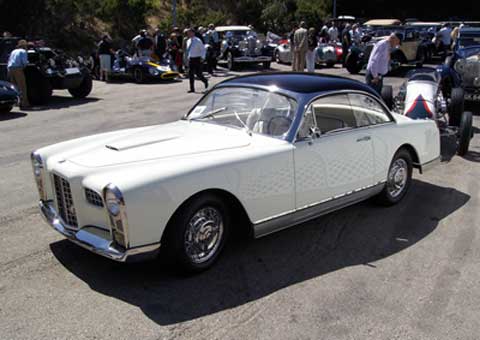
The first Facel Vega, built in 1954, seen at Monterey last year.
Facel Vega: Le Dernier Astre Francais.
At the end of the second world war, France was destitute and virtually bankrupt. Much of its industrial base was destroyed, as well as the basic infrastructure, such as railway lines, bridges, roads, etc. A socialist government took power, and their tax policies taxes on luxury cars were punitive.
Slowly, the “grandes routieres” of the past, Bugatti, Delahaye, Delage, Talbot, faded away, taxed to death, you might say.
Today, the French look back on that period, from 1945 to 1975, as “les trentes glorieuses,” 30 glorious years, because of course they did ultimately rebuild their economy and their country.
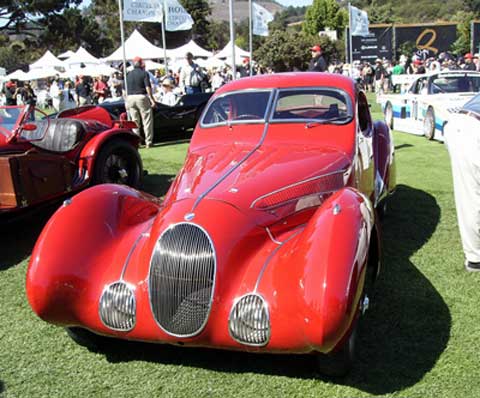
Talbot-Lago “grandes routiere”. Photo Brandy Elitch.
And one of the most glorious things during that period was the emergence of “the last French star,” the Facel Vega. Like most great cars, it was the creation of one man, Jean Daninos. Daninos started his automotive career in 1928, at Citroen. He founded his own company in 1939, Forges et Ateliers de Constructions d’Eure et Loire, (Facel for short; the French love acronyms). After the war, he built car bodies for other manufacturers (Panhard, Simca, and Ford of France), including the French Ford Comete, which was the precursor of the Vega.
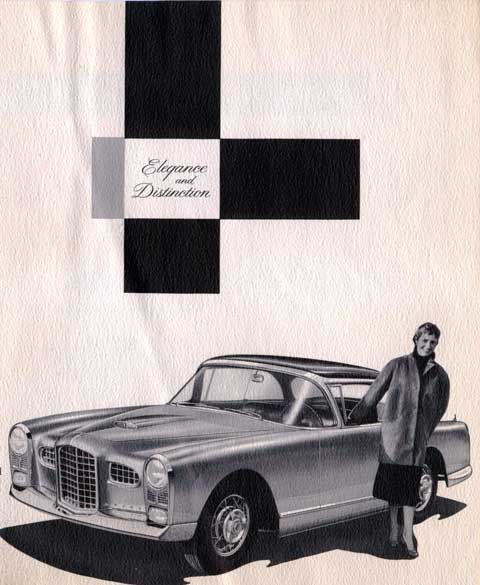
The Facel Vega sales brochure from the late 1950s. Courtesy Michel Revoy.
His brother was the author of a best selling book (“The Notebooks of Major Thomson”) and it was he who suggested the name Vega, the brightest star. The first Facel Vega was shown at the 1954 Paris show, with a DeSoto hemi motor and a Pont-a-Mousson 4 speed box. The car was expensive, but still very competitive with its rivals. In 1960, it was priced at 39,500FF, compared to the Aston Martin (64,000), the Maserati 3500 (63,000), and the BMW 503 (55,000). Total production for the FV and HK 500 was 849, plus 11 convertibles.
The Facel Vega was designed as a high speed touring car, for cruising the Routes Nationales, the French highways that linked the big cities of France before the Autoroutes, and for that purpose it was unmatched. But purists always suggested that just because it didn’t have an independent rear suspension, or a DOHC motor, it was somehow below its more expensive competitors in stature. This reasoning is fallacious. Instead of comparing the Facel to the Italian GT’s, it would make more sense to compare it to the Bristol, the Jensen, and even the Bentley Continental, which in fact Jean Daninos tried to emulate, in my opinion. Yes, the motor was a pushrod OHV, but what a motor!: the most magnificent American motor of the postwar period, the Chrysler Hemi (and its Dodge and DeSoto derivatives). And yes, it would be nice to find one with the original manual gearbox, but the wealthy people who bought these cars new usually opted for the Torqueflite, arguably the finest automatic transmission of the period as well. As Chrysler collectors know, the last year for the Hemi was 1958; it was simply too expensive to manufacture, and Chrysler replaced it with the 413, which like the hemi, went into the New Yorkers and Imperials. At that point, the Facel got the 383, another excellent motor.
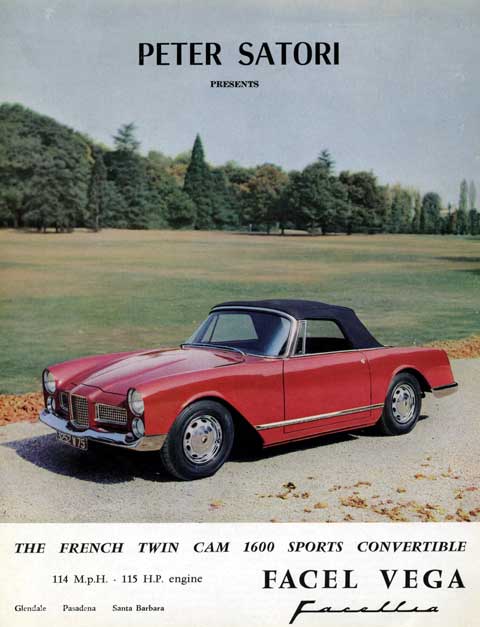
Brochure for the DOHC Facellia. Courtesy Michel Revoy.
At that point, Daninos tried to go down market by making a smaller, less expensive version, called the Facellia. Unfortunately, problems with the original dohc motor, manufactured by Pont-a-Mousson, virtually bankrupted the company. Had Daninos not tried this grand experiment, he may have soldiered on until at least the early 1970’s by building updated versions of the Facel II, but this was not to be.
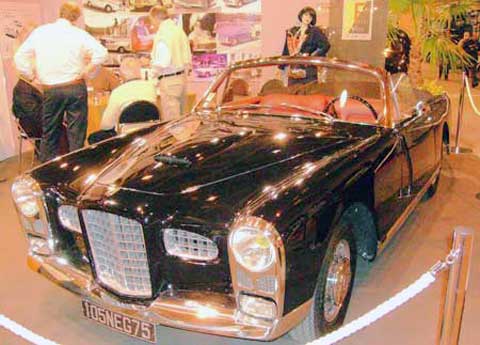
Rare Facel Vega convertible as seen at Retro 2008. Photo Brandy Elitch.
Another criticism of the car at the time was that it was heavy, but that missed the point entirely; it was designed as a “grande routiere,” not a GT car. The Vega (and its predecessor, the FV models) was made from 1955 through 1961, when it was replaced by an updated model, the Facel II, another extremely elegant car, of which 184 were made.
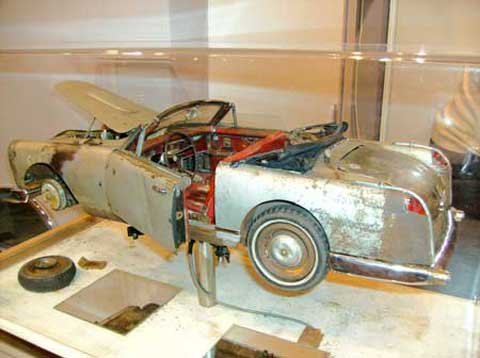
A small model of a Facel in restoration. Big car, big work, but today, a worthwhile project. Photo Brandy Elitch.
Daninos died in 2001 at age 94. At the 2000 Retromobile, he was on the club stand, and he kindly autographed a picture of my car, something I will always treasure. Until recently, there was only one book on Facel, “Facel-Vega, Toute L’Histoire,” by Michel G. Renou, EPA, 1994. However, I see that last year Palawan Press unveiled a new book, priced (like their other books) at almost $500. If this does not fit your budget, there are numerous magazine articles on the Facel in the French collector car magazines, such as Retroviseur. Even today, it is really the last of the great “stars” in French manufacture, except for the Citroen SM of course. And finally, here is a fact not generally known: the dashboard of the HK 500, one of the most beautiful anywhere, is not wood; it is painted on metal, and every dash was done by the same one painter for the entire production run!
After being somewhat neglected in the collector car world, at least here in the States, these cars are in great demand now, and are not easy to find. It interesting to see two convertibles at Retromobile in 2008, one on the club stand, fully restored, and the second for sale on a dealer’s stand in original condition, or “dans son jus,” as the French say.
There is an active club, the Amicale Facel-Vega, which remanufactures parts no longer available, publishes a magazine, and maintains a history of the company, including archives, records, and interviews with old employees (see: www.facel-vega.asso.fr). The club maintains an extensive record of every car, including original color, accessories, and where it was sold. Today, the name Facel-Vega belongs exclusively to the club. It was founded in 1975 and today has almost 500 members, including 120 outside France, who own more than 600 cars.
“A Facel in restoration. Big car, big work, but today, a worthwhile project. Photo Brandy Elitch”
This was a SMALL car on display at Retromobile on the Facel Vega stand – about one sixth scale in fact. Note the plexi case. Nicely done model – I wanted to bring it home with me – in my carry-on luggage.
In the early eighties I was riding my motorcycle in Chicago and took an alley to escape road construction. There was a large crowd in the alley watching two men fighting. I asked what was going on and a person said “they’re fighting over who owns that car.” I looked past the mayhem and there sat an auto I’d never seen before; a 1959 Facel Vega HK500. The fight ended and being a complete gearhead I went up to them and asked them if they’d want to sell it. They looked at each other and said “how much?” Knowing nothing of the car or if it even ran I picked a number out of the air. “$900.00”. They blinked and said…yes. I had my checkbook and Voila! I was the new owner. It ran (hemi with dual quads, pushbutton ) but didn’t stop (Rudge wheels I believe). It had impressive fitted luggage in the trunk cleverly hiding rust. I believe it also had an all band radio. After repairing various mechanical systems and wiring the rust got the best of me and I traded it for 1953 Studebaker Commander Starlite Coupe in excellent condition. Another great looking auto but not a Facel Vega. That one got away. Richard
I too had one get away in the mid 80’s. Responding to an add in the local paper (Sacramento, Ca), I bought an early series II that was complete and running with non-functioning brakes. I had to put a deposit on it and was to pay it off a week later. When I returned the following week, the seller had resold it for $1000 more than our agreed upon price and returned my deposit with an additional $100. He said the car was headed to France. I almost got to drive one…
I’m glad to find your source. Beautiful site. I’ll become your regular visitor and RSS subscriber.
Le seul livre qui dit la vérité sur l’histoire Facel Vega est celui, malheureusement qu’en français, de l’historien reconnu Michel G. Renou.